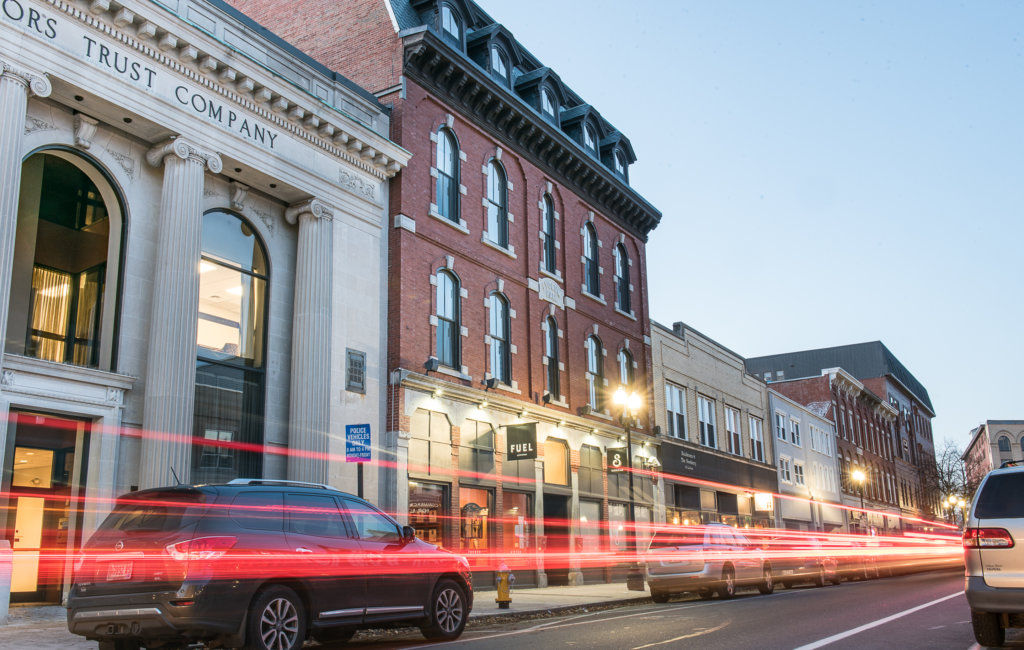
The brick Lyceum Hall building that houses Fuel restaurant on Lisbon Street in Lewiston is one of several high-profile historic buildings in the city that were redeveloped with the use of the federal historic tax credit. The credit has been eliminated in the recently passed U.S. House tax-reform plan. (Russ Dillingham/Sun Journal)
LEWISTON — A tax credit that U.S. House Republicans have axed as part of their tax reform plan has been essential to the success of a number of high-profile redevelopments in Lewiston, and eliminating it could jeopardize several pending projects, according to city officials and local developers.
Redevelopments including The Lofts at Bates Mill No. 2, Lyceum Hall (the home of Fuel restaurant) and the Agora Grand Event Center have all taken advantage of the federal historic tax credit program, which provides tax breaks to developers of historic preservation projects.
The Republican-led U.S. House of Representatives approved a tax reform bill Thursday that, among many tax changes, calls for eliminating the historic tax credit, putting into question redevelopment projects nationwide.
According to Lewiston officials, as the city has worked with business owners and investors to revitalize its downtown by repurposing historic mill buildings and downtown storefronts, dozens of projects all told have relied on the program to make them financially feasible.
The officials and local developers also noted last week that a number of pending projects in Lewiston, including the ongoing redevelopment of Bates Mill No. 5 and the creation of an investment-spurring downtown historic district for Lisbon and Main streets, could be in jeopardy if the tax credit program disappears.
Lincoln Jeffers, director of economic and community development in Lewiston, said this week that losing the program would “put a chill on the redevelopment we’re seeing” in Lewiston.
The federal program offers a 20 percent income tax credit for rehabilitation expenses on historic buildings, attracting private capital to projects that have a financing gap between what a bank will lend and the total development cost.
Jeffers said he doubts projects like the Agora Grand, The Lofts at Bates Mill and Lyceum Hall would have gone forward without the tax incentive.
“Having been close to nearly all of these projects I can confidently say that historic tax credits were an important part of the financing package for each, and but for that source of funding, they likely would not have gone forward, or would have required a significant investment of local public dollars, such as (tax-increment financing), to go forward,” he said.
PROJECTS IN JEOPARDY
At least two Lewiston developers said eliminating the credit would have a big impact on their current projects.
Jules Patry, owner of DaVinci’s Eatery in Lewiston, has been working to redevelop the former Scruton Block building at 199 Lisbon St., which most recently housed Compass Coin & Jewelry. Earlier this year, he removed the aluminum siding, exposing the original brick structure underneath. The site was the original home of Marcotte Furniture World.
“Without the historic tax credits, I don’t think the project can happen,” Patry said Tuesday from his restaurant.
His Lisbon Street building was also used in a city grant application earlier this year, which would lead to the creation of a Downtown Lisbon Street/Main Street National Register of Historic Places District.
The historic district would encompass 85 buildings, 65 of which would likely be eligible for historic register status, thus making them eligible for the tax credits as well.
However, without the federal tax credit program, creating the district likely wouldn’t move forward, both Patry and Jeffers said.
To qualify for the credit, a building must be income-producing or used in a trade or business, and the cost of rehabilitation must exceed the pre-rehabilitation cost of the building.
Tom Platz, owner of the Auburn architectural company Platz Associates, said Wednesday that eliminating the historic tax credit would “drastically affect the financials” on his Bates Mill No. 5 redevelopment project, which has been years in the making.
But, he said, he wouldn’t go so far as to say the project would be doomed without the credits.
“It just means trying to find that money elsewhere to make the rents affordable,” he said, referring to any future residential or commercial uses at the site. “The tax credits really start to make it feasible in this area for that kind of development.”
Jeffers agreed, saying, “Maine’s economy just does not support the cost of new construction.” He said his department has been keeping a “close eye” on the tax bill.
EYES ON WASHINGTON
Patry said he’s been following the tax plan discussions in Washington, but he’s remaining hopeful that the final version of the bill will not include any cuts to the tax credit.
The Senate Finance Committee’s version of the tax reform bill proposes cutting the historic tax credit in half, from 20 percent to 10 percent. The House passed its version of the bill Thursday — mostly along party lines. The Senate vote likely will come after Thanksgiving.
Currently, the two tax reform bills include some big differences. If the Senate’s version is also approved, the two bills will have to be aligned in committee before one bill can move on to the president for his consideration.
Last week, Maine Preservation, which advocates for policies that encourage historic preservation in Maine, ramped up its outreach efforts to the Maine congressional delegation in order to save the tax credits.
The organization has been urging people to contact U.S. Sens. Susan Collins and Angus King and U.S. Reps. Bruce Poliquin and Chellie Pingree to advocate for the credit to remain untouched.
Pingree on Thursday voted against the bill; Poliquin voted in favor.
Greg Paxton, executive director of Maine Preservation, said this week that it’s “very clear” that this portion of the country’s tax code “produces economic development.”
The organization has said that in the past 10 years, 83 projects have used the federal historic tax credit in Maine, creating 5,180 new jobs and 1,440 housing units, while generating $42.2 million in taxes and more than $700 million in total economic impact.
‘CULTURALLY VALUABLE’
Much of that impact has been felt in small cities and rural communities. According to the National Trust for Historic Preservation, over 40 percent of projects financed in the past 15 years are in communities with populations less than 25,000.
“If we’re seeking incentives for economic development, this is already an incentive that’s working,” Paxton said, adding that the proposal to eliminate the credit “is certainly not based on the merits.”
An article in this week’s Advertiser Democrat in Norway cited examples of the tax credit being used in smaller regional communities including Norway, Bethel and Livermore Falls.
The tax credit was a significant factor in the successful $1.4 million restoration of the Norway Opera House in 2012, the anchor of the Norway Downtown Historic District. The credits were used to redevelop the Lamb Block in Livermore Falls and the Gearing Clinic in Bethel.
Maine Preservation administers the Maine historic preservation tax credit, which combines with the federal credit to offer a 45 percent income tax rebate on the rehabilitation cost of commercial and rental properties.
Paxton noted that all of the work required to gain both the federal and state tax credits must occur first — meaning construction is complete and tenants are in place — before a developer can claim the tax credit.
Currently, the federal program also offers a 10 percent credit for non-historic buildings built prior to 1936, which was used for the first Bates Mill projects as well as the Healy Asylum redevelopment.
If the credits are eventually eliminated, Platz said, there’s no doubt it would affect redevelopment projects in the pipeline. But, more important, he believes it would lead to the loss of historic buildings across the country.
The National Trust for Historic Preservation says the historic tax credit has been used to preserve more than 42,293 historic buildings nationwide since it was implemented in 1978.
“It’s going to get rid of a lot of culturally valuable historic buildings in the country,” Platz said. “It will give no incentive for saving some of this stuff that this country was built on.”
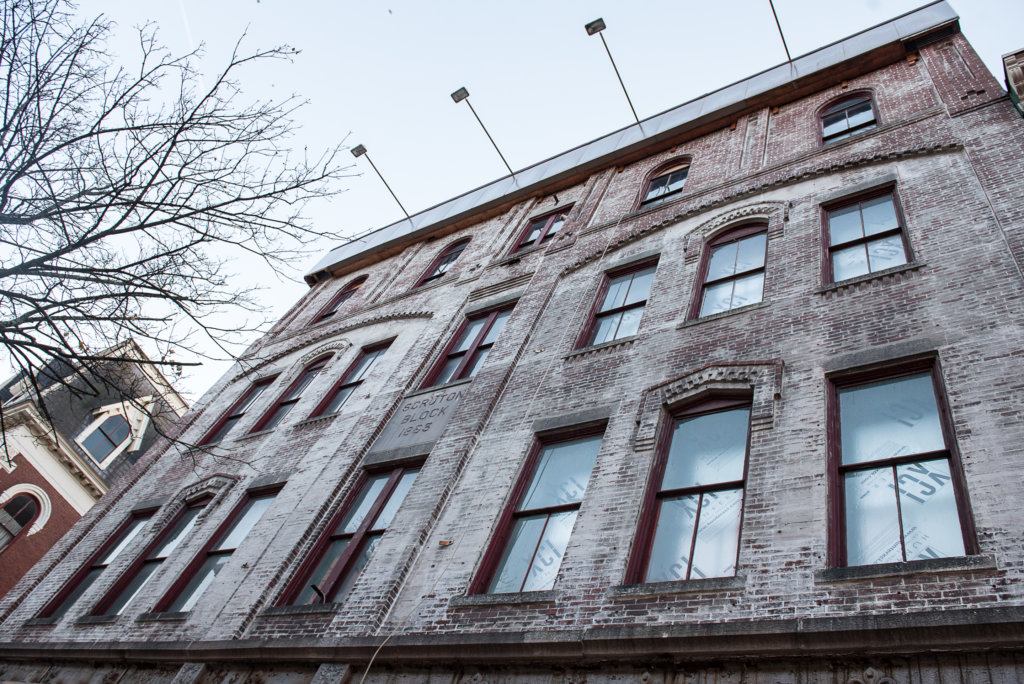
The former Marcotte Furniture World and Compass Coin & Jewelry at 199 Lisbon St. in Lewiston is under renovation. Owner Jules Patry said the project would be in jeopardy if the federal historic tax credit is eliminated, as intended in the tax-reform bill recently passed by the U.S. House. (Russ Dillingham/Sun Journal)
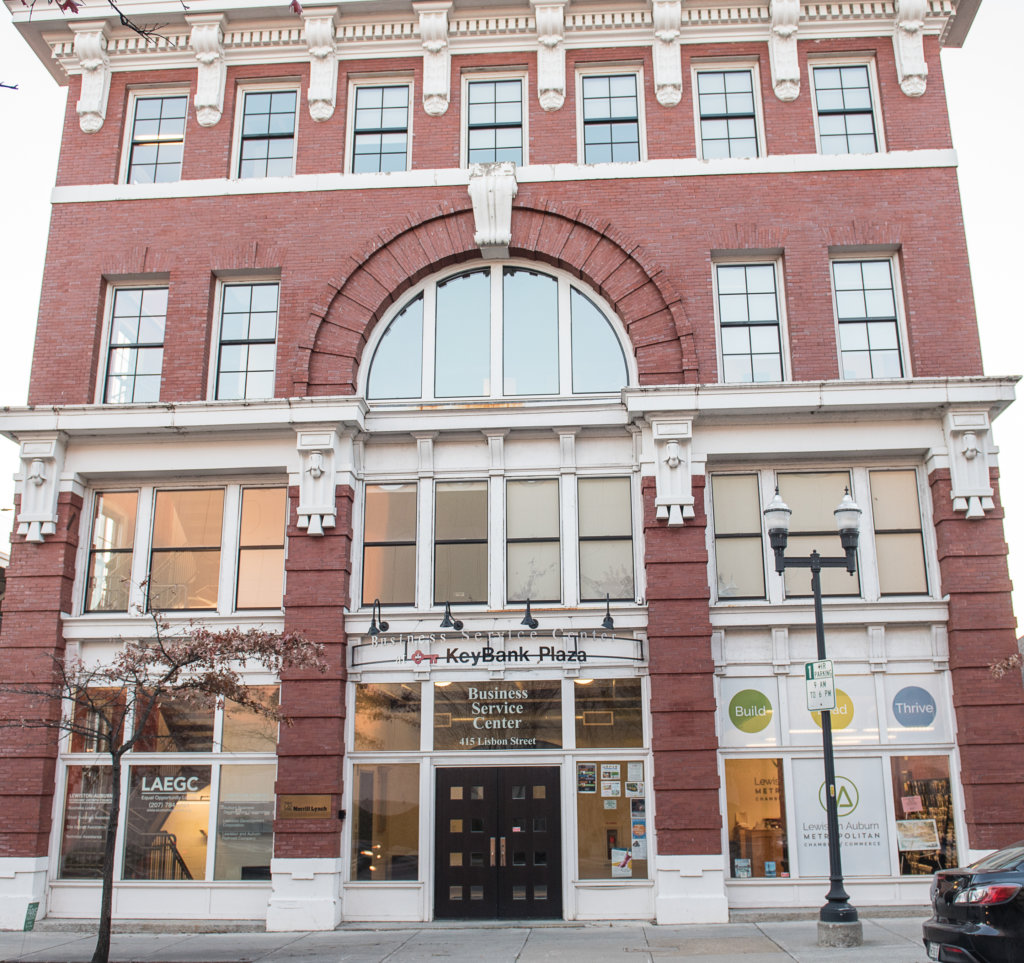
Developers of the Key Bank Plaza and Business Service Center at 415 Lisbon St. in Lewiston, headquarters for the Chamber of Commerce and the Lewiston Auburn Economic Growth Council, relied on the federal historic tax credit to finance the building’s redevelopment. (Russ Dillingham/Sun Journal)
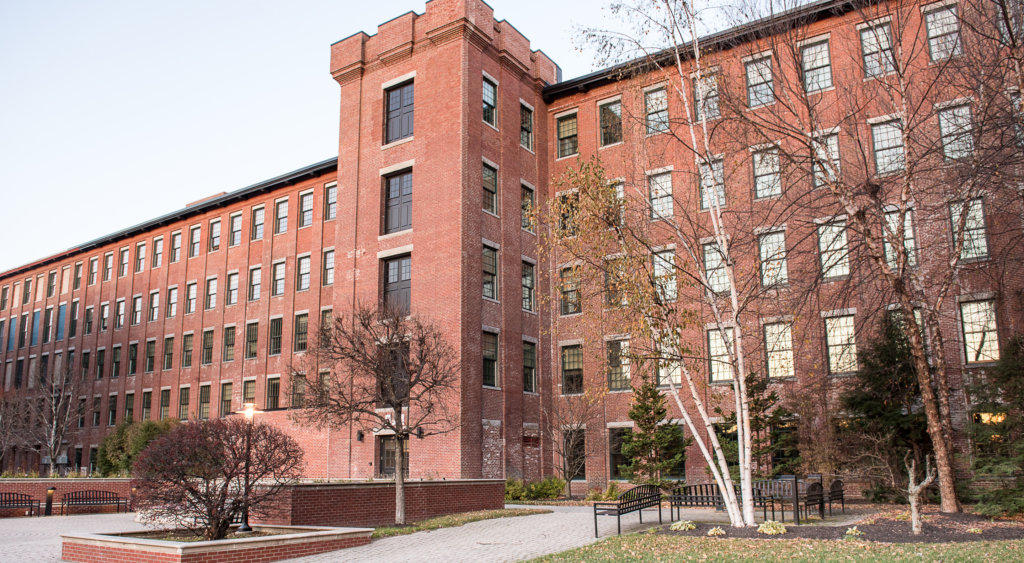
Developers of The Lofts at Bates Mill on Lincoln Street in Lewiston relied on the federal historic tax credit to help finance the building’s redevelopment. (Russ Dillingham/Sun Journal)
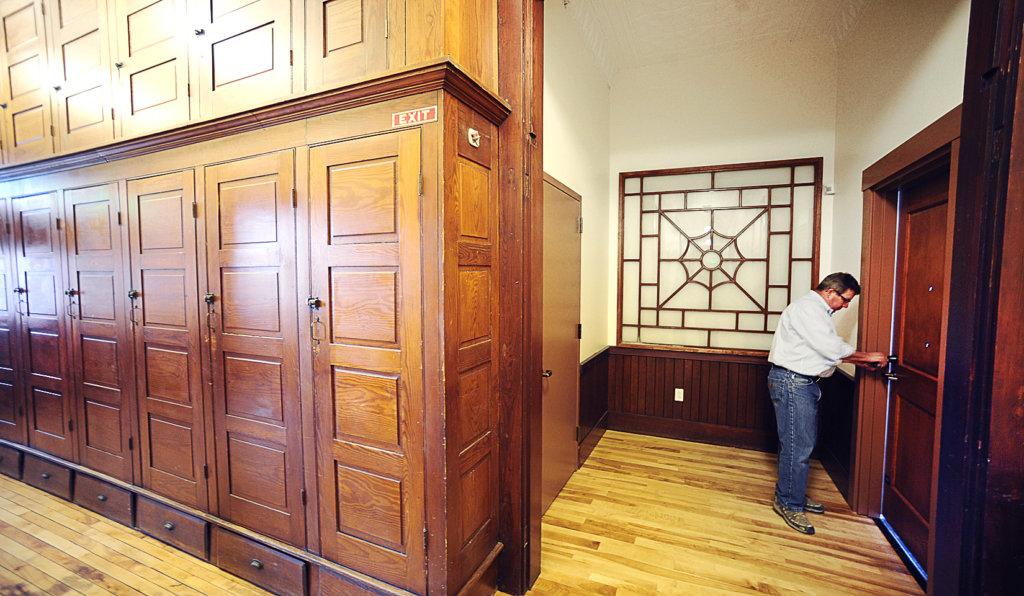
Thomas Maxfield, regional operations manager for Preservation Management Inc. of South Portland, unlocks a door to one of the apartments at the former Intown Manor and Healy Asylum at 81 Ash St. in Lewiston in 2012. The redevelopment of the building relied in part on the federal historic tax credit. (Russ Dillingham/Sun Journal)
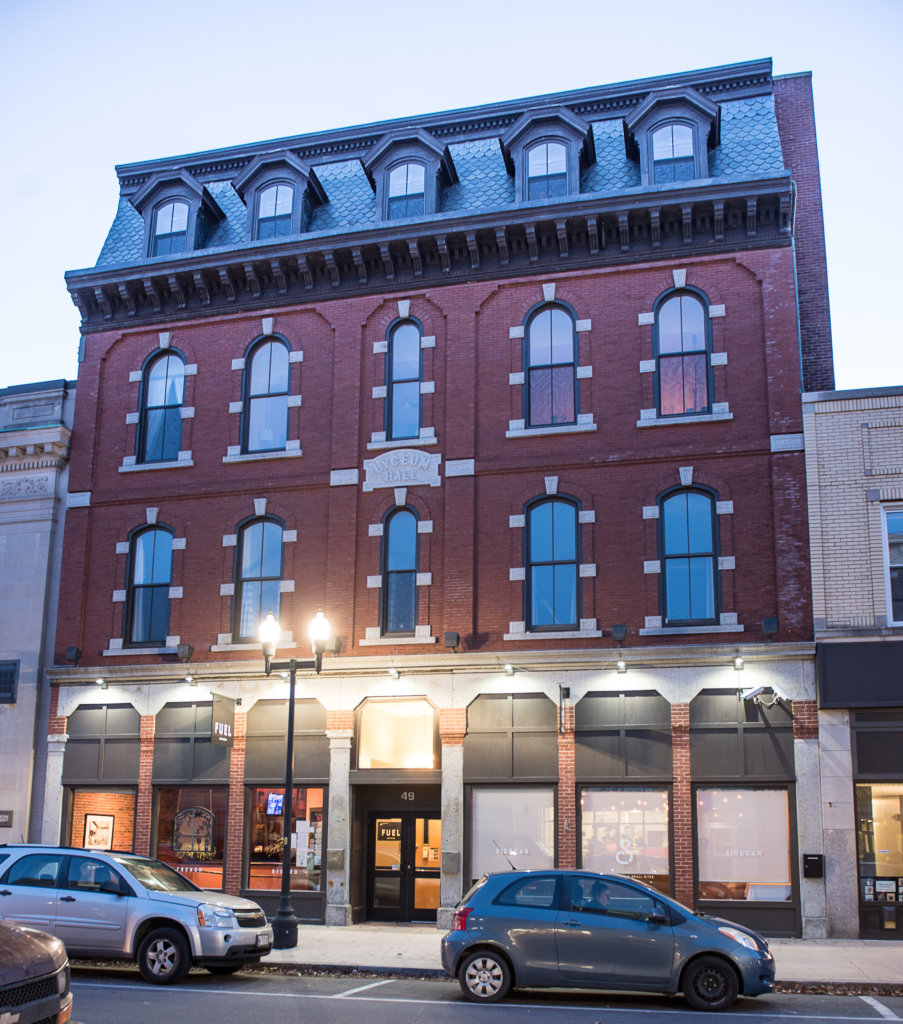
The brick Lyceum Hall building that houses Fuel restaurant on Lisbon Street in Lewiston is one of several high-profile historic buildings in the city redeveloped with the use of the federal historic tax credit. The credit has been eliminated in the recently passed U.S. House tax reform plan. (Russ Dillingham/Sun Journal)
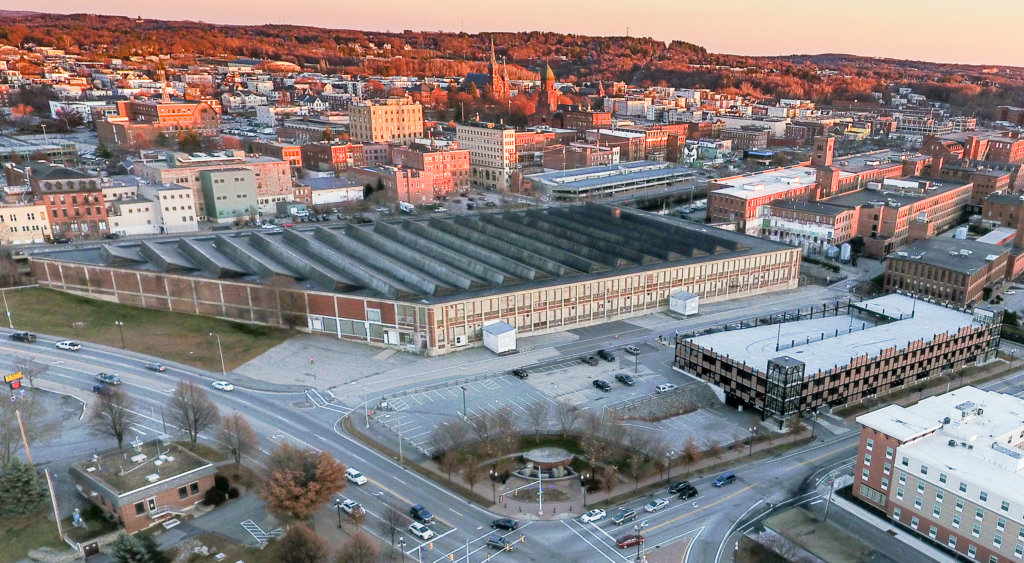
The redevelopment of Bates Mill No. 5 in Lewiston, seen in this aerial photo, and other projects in Maine will be more difficult if Congress eliminates the federal historic tax credit, development officials say. (Russ Dillingham/Sun Journal)
Comments are no longer available on this story